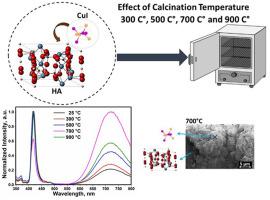Optical Materials ( IF 3.8 ) Pub Date : 2021-09-13 , DOI: 10.1016/j.optmat.2021.111559 Sohrab Nasiri 1, 2 , Mozhgan Hosseinnezhad 3 , Marzieh Rabiei 1 , Arvydas Palevicius 1 , Giedrius Janusas 1

|
Nanocomposite consisting of 5 mol% crystalline CuI-doped hydroxyapatite (HA) was prepared for the first time by facile chemical method and calcined at different temperatures such as 300 °C, 500 °C, 700 °C and 900 °C. In this study, HA played a role as the matrix and CuI was the reinforcement. The effect of calcination temperature on XRD pattern, TEM, SEM, BET, FTIR, luminescence intensity, photoluminescence quantum yield (PLQY), fluorescence lifetime, charge mobility measurements, electronic speckle pattern interferometry and mechanical properties were investigated. The modified Scherrer equation of the composites showed that the size of the particles increased with increasing calcination temperature from 66.64 to 87.20 nm. The photoluminescence intensity of CuI (5 mol%)/HA was quenched at room temperature, while the represented constant decay time for the calcined compound was increased at 700 °C. Furthermore, the CIE coordinates were shown 0.39333, 0.18493 for CuI (5 mol%)/HA calcined at 700 °C. The charge mobility values of the nanocomposites were extracted by space-charge limited current (SCLC) method and the range of effective mobility was from 3.645 × 10−4 to 6.697 × 10−4 cm2V−1s−1. Mechanical properties were fully discussed via ASTM-E9 standard and CuI (5 mol%)/HA calcined at 900 °C was in better range than other compounds, the σyc and hardness values were reported 7.32 Mpa and 40.81 HV respectively. Speckle interferometry was used to demonstrate that there was no large imperfection in the surface of each sample. The components were very sensitive to the calcination temperatures. In other words, the combination of CuI (5 mol%)/HA showed that the replacement of Cu ions with Ca was helpful to improve the photophysical and mechanical properties.
中文翻译:

煅烧温度对碘化铜 (5 mol%) 掺杂羟基磷灰石光物理和机械性能的影响
首次通过简便的化学方法制备了由 5 mol% 结晶 CuI 掺杂的羟基磷灰石 (HA) 组成的纳米复合材料,并在 300 °C、500 °C、700 °C 和 900 °C 等不同温度下煅烧。在这项研究中,HA 起到了基质的作用,而 CuI 起到了增强作用。研究了煅烧温度对XRD图谱、TEM、SEM、BET、FTIR、发光强度、光致发光量子产率(PLQY)、荧光寿命、电荷迁移率测量、电子散斑图干涉测量和机械性能的影响。复合材料的修正 Scherrer 方程表明,随着煅烧温度从 66.64 增加到 87.20 nm,颗粒的尺寸增加。CuI (5 mol%)/HA 的光致发光强度在室温下淬灭,而煅烧化合物的代表恒定衰减时间在 700 °C 时增加。此外,在 700 °C 下煅烧的 CuI (5 mol%)/HA 的 CIE 坐标显示为 0.39333、0.18493。通过空间电荷限制电流(SCLC)方法提取纳米复合材料的电荷迁移率值,有效迁移率范围为 3.645 × 10-4至 6.697 × 10 -4 cm 2 V -1 s -1。通过 ASTM-E9 标准充分讨论了机械性能,在 900 °C 下煅烧的 CuI (5 mol%)/HA 比其他化合物处于更好的范围内,σ yc和硬度值分别报告为 7.32 Mpa 和 40.81 HV。散斑干涉法用于证明每个样品的表面没有大的缺陷。这些组分对煅烧温度非常敏感。换句话说,CuI (5 mol%)/HA 的组合表明用 Ca 替代 Cu 离子有助于提高光物理和机械性能。











































 京公网安备 11010802027423号
京公网安备 11010802027423号